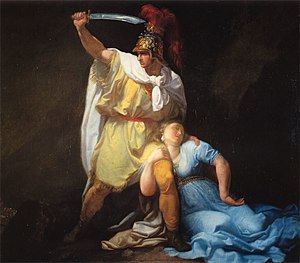Luigi Sabatelli: Difference between revisions
Florence |
RjwilmsiBot (talk | contribs) m →References: Adding Persondata using AWB (7393) |
||
| Line 9: | Line 9: | ||
*{{cite book | first=Ashton|last=Rollins Willard| year=1900| title=History of Modern Italian Art| editor =| pages=282| publisher= Longmans, Green & co., 39 Paternoster Row, London; Digitized by Googlebooks| id= |url=http://books.google.com/books?id=GBPHNHXg7CIC&pg=PA3&dq=Ashton+Rollins+Willard+History+Modern| authorlink=}} |
*{{cite book | first=Ashton|last=Rollins Willard| year=1900| title=History of Modern Italian Art| editor =| pages=282| publisher= Longmans, Green & co., 39 Paternoster Row, London; Digitized by Googlebooks| id= |url=http://books.google.com/books?id=GBPHNHXg7CIC&pg=PA3&dq=Ashton+Rollins+Willard+History+Modern| authorlink=}} |
||
{{Persondata <!-- Metadata: see [[Wikipedia:Persondata]]. --> |
|||
| ⚫ | |||
| NAME = Sabatelli, Luigi |
|||
| ALTERNATIVE NAMES = |
|||
| SHORT DESCRIPTION = |
|||
| DATE OF BIRTH = 21 February 1772 |
|||
| PLACE OF BIRTH = |
|||
| DATE OF DEATH = 29 January 1850 |
|||
| PLACE OF DEATH = |
|||
}} |
|||
{{DEFAULTSORT:Sabatelli, Luigi}} |
{{DEFAULTSORT:Sabatelli, Luigi}} |
||
[[Category:1772 births]] |
[[Category:1772 births]] |
||
[[Category:1850 deaths]] |
[[Category:1850 deaths]] |
||
| Line 18: | Line 25: | ||
[[Category:Italian painters]] |
[[Category:Italian painters]] |
||
[[Category:Tuscan painters]] |
[[Category:Tuscan painters]] |
||
| ⚫ | |||
[[br:Luigi Sabatelli]] |
[[br:Luigi Sabatelli]] |
||
Revision as of 21:35, 21 November 2010

Luigi Sabatelli (21 February 1772 – 29 January 1850) was an Italian painter of the Neoclassic period, active in Milan, Rome, and his native city of Florence.
By some, Sabatelli was regarded as the most talented of the Tuscan painters of the generation after Pietro Benvenuti. He studied in his native city and in Rome. In 1808 he accepted a professorship of painting at the Academy of Fine Arts at Milan and held the post until his death, except for a brief furlough between 1822 and 1825. His first important work in oils was the large picture representing the Meeting of David and Abigail, which now hangs opposite Benvenuti's Judith in the Lady Chapel of the cathedral at Arezzo. Sabatelli's reputation rests on frescos (1822–1825) in the Hall of the Iliad at the Pitti Palace (the first room of the Picture Gallery), consisting of eight lunettes and a large circular medallion illustrating scenes from the Homeric poems.
His sons, Giuseppe (1813–1843) and Francesco Sabatelli (1801–1829), were painters and professors of art in Florence.
References
- Rollins Willard, Ashton (1900). History of Modern Italian Art. Longmans, Green & co., 39 Paternoster Row, London; Digitized by Googlebooks. p. 282.
